ECU Lexus IS220d 2012 Owner's Guide
[x] Cancel search | Manufacturer: LEXUS, Model Year: 2012, Model line: IS220d, Model: Lexus IS220d 2012Pages: 609, PDF Size: 14.63 MB
Page 160 of 609
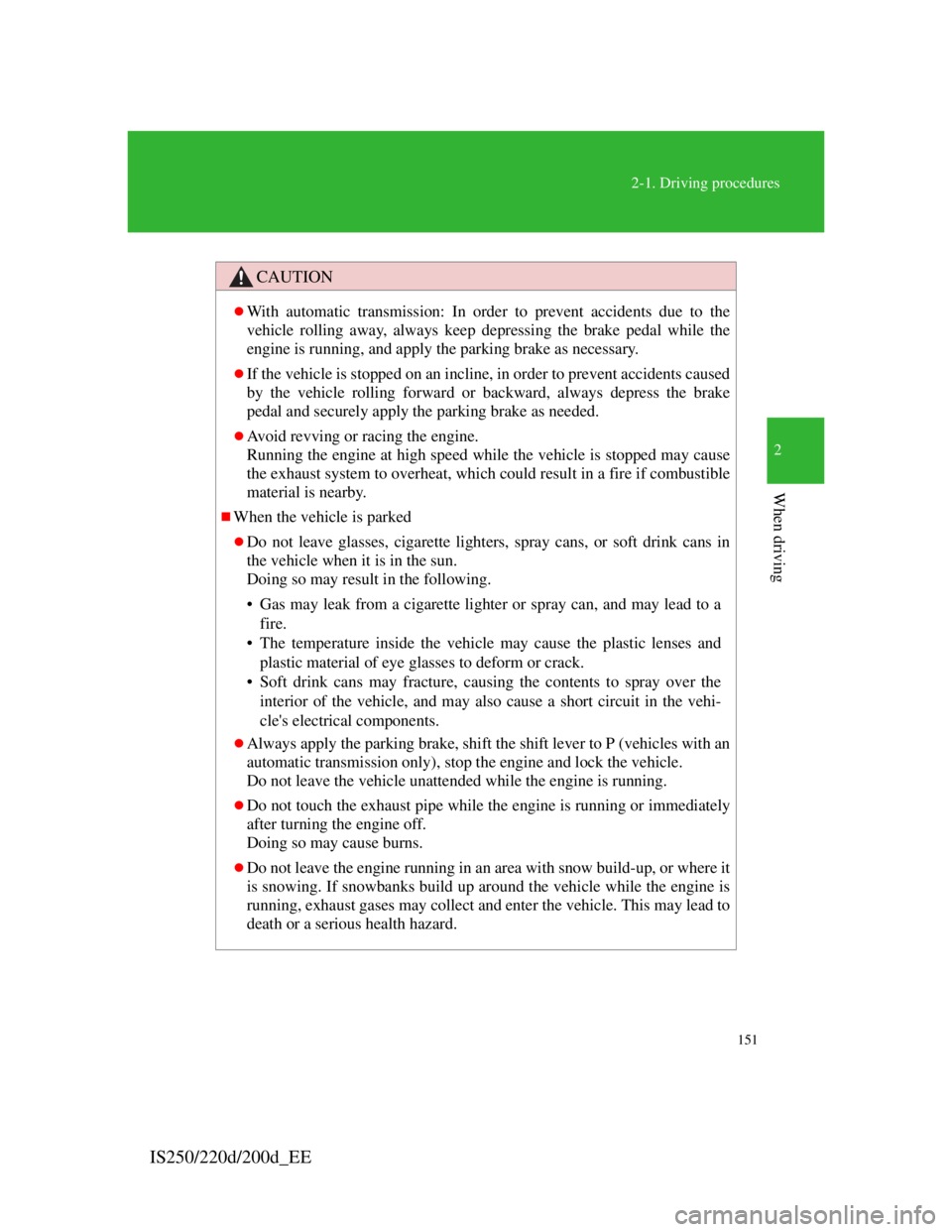
151
2-1. Driving procedures
2
When driving
IS250/220d/200d_EE
CAUTION
With automatic transmission: In order to prevent accidents due to the
vehicle rolling away, always keep depressing the brake pedal while the
engine is running, and apply the parking brake as necessary.
If the vehicle is stopped on an incline, in order to prevent accidents caused
by the vehicle rolling forward or backward, always depress the brake
pedal and securely apply the parking brake as needed.
Avoid revving or racing the engine.
Running the engine at high speed while the vehicle is stopped may cause
the exhaust system to overheat, which could result in a fire if combustible
material is nearby.
When the vehicle is parked
Do not leave glasses, cigarette lighters, spray cans, or soft drink cans in
the vehicle when it is in the sun.
Doing so may result in the following.
• Gas may leak from a cigarette lighter or spray can, and may lead to a
fire.
• The temperature inside the vehicle may cause the plastic lenses and
plastic material of eye glasses to deform or crack.
• Soft drink cans may fracture, causing the contents to spray over the
interior of the vehicle, and may also cause a short circuit in the vehi-
cle's electrical components.
Always apply the parking brake, shift the shift lever to P (vehicles with an
automatic transmission only), stop the engine and lock the vehicle.
Do not leave the vehicle unattended while the engine is running.
Do not touch the exhaust pipe while the engine is running or immediately
after turning the engine off.
Doing so may cause burns.
Do not leave the engine running in an area with snow build-up, or where it
is snowing. If snowbanks build up around the vehicle while the engine is
running, exhaust gases may collect and enter the vehicle. This may lead to
death or a serious health hazard.
Page 162 of 609
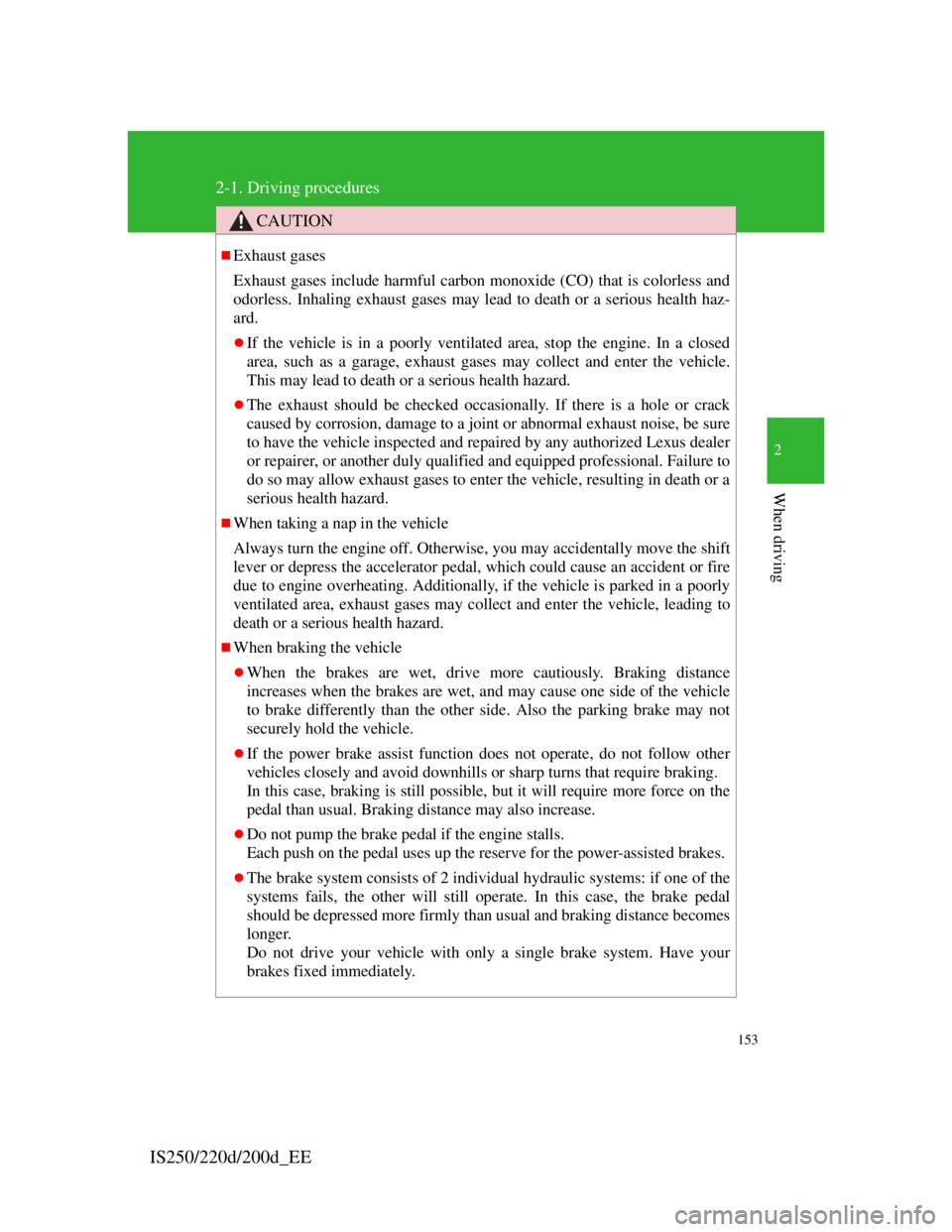
153
2-1. Driving procedures
2
When driving
IS250/220d/200d_EE
CAUTION
Exhaust gases
Exhaust gases include harmful carbon monoxide (CO) that is colorless and
odorless. Inhaling exhaust gases may lead to death or a serious health haz-
ard.
If the vehicle is in a poorly ventilated area, stop the engine. In a closed
area, such as a garage, exhaust gases may collect and enter the vehicle.
This may lead to death or a serious health hazard.
The exhaust should be checked occasionally. If there is a hole or crack
caused by corrosion, damage to a joint or abnormal exhaust noise, be sure
to have the vehicle inspected and repaired by any authorized Lexus dealer
or repairer, or another duly qualified and equipped professional. Failure to
do so may allow exhaust gases to enter the vehicle, resulting in death or a
serious health hazard.
When taking a nap in the vehicle
Always turn the engine off. Otherwise, you may accidentally move the shift
lever or depress the accelerator pedal, which could cause an accident or fire
due to engine overheating. Additionally, if the vehicle is parked in a poorly
ventilated area, exhaust gases may collect and enter the vehicle, leading to
death or a serious health hazard.
When braking the vehicle
When the brakes are wet, drive more cautiously. Braking distance
increases when the brakes are wet, and may cause one side of the vehicle
to brake differently than the other side. Also the parking brake may not
securely hold the vehicle.
If the power brake assist function does not operate, do not follow other
vehicles closely and avoid downhills or sharp turns that require braking.
In this case, braking is still possible, but it will require more force on the
pedal than usual. Braking distance may also increase.
Do not pump the brake pedal if the engine stalls.
Each push on the pedal uses up the reserve for the power-assisted brakes.
The brake system consists of 2 individual hydraulic systems: if one of the
systems fails, the other will still operate. In this case, the brake pedal
should be depressed more firmly than usual and braking distance becomes
longer.
Do not drive your vehicle with only a single brake system. Have your
brakes fixed immediately.
Page 182 of 609

173
2-1. Driving procedures
2
When driving
IS250/220d/200d_EE
Horn
After adjusting the steering wheel (vehicles with manually adjustable steer-
ing wheel)
Make sure that the steering wheel is securely locked.
The horn may not sound if the steering wheel is not securely locked. (P.
79)
To sound the horn, press on
or close to the mark.
Page 251 of 609
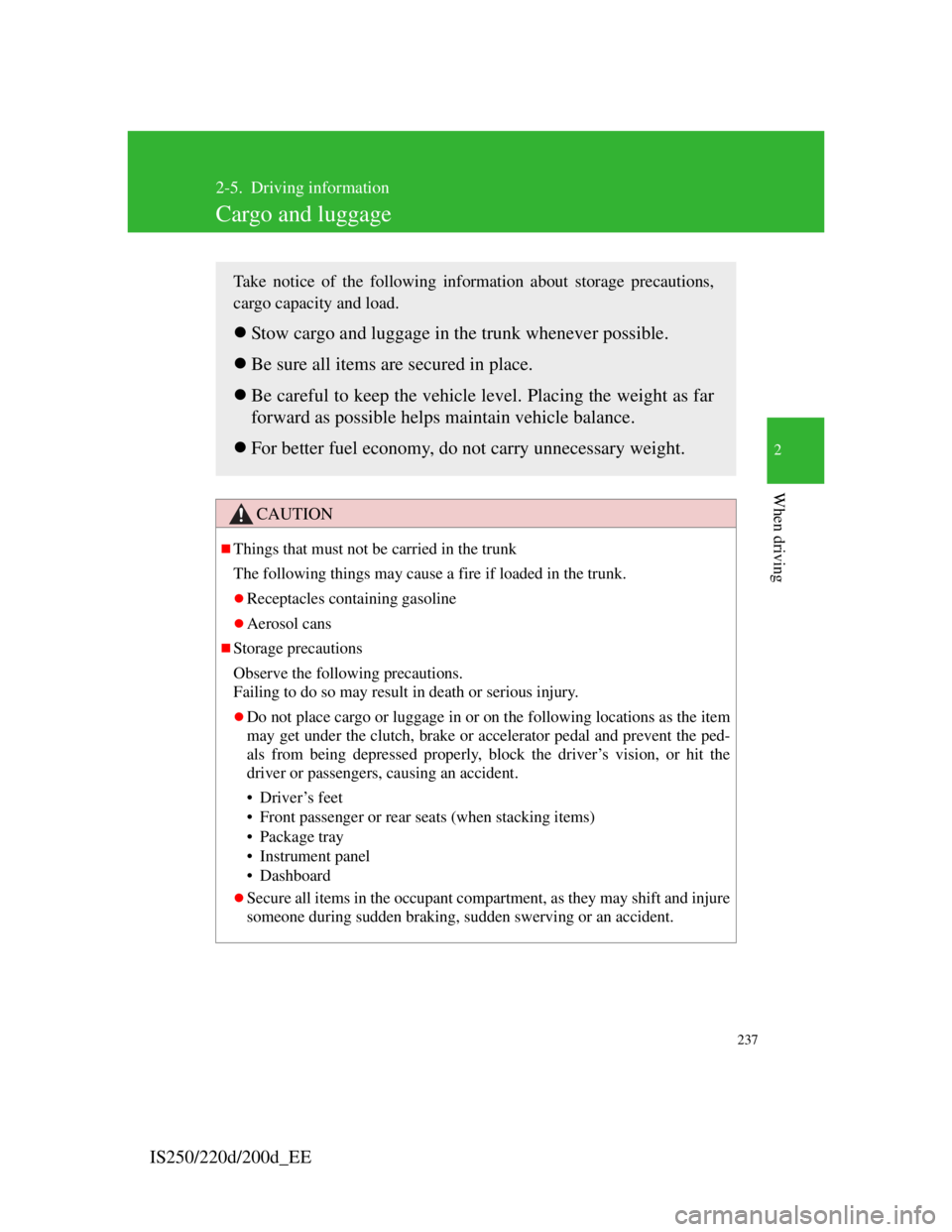
237
2
When driving
IS250/220d/200d_EE
2-5. Driving information
Cargo and luggage
CAUTION
Things that must not be carried in the trunk
The following things may cause a fire if loaded in the trunk.
Receptacles containing gasoline
Aerosol cans
Storage precautions
Observe the following precautions.
Failing to do so may result in death or serious injury.
Do not place cargo or luggage in or on the following locations as the item
may get under the clutch, brake or accelerator pedal and prevent the ped-
als from being depressed properly, block the driver’s vision, or hit the
driver or passengers, causing an accident.
• Driver’s feet
• Front passenger or rear seats (when stacking items)
• Package tray
• Instrument panel
• Dashboard
Secure all items in the occupant compartment, as they may shift and injure
someone during sudden braking, sudden swerving or an accident.
Take notice of the following information about storage precautions,
cargo capacity and load.
Stow cargo and luggage in the trunk whenever possible.
Be sure all items are secured in place.
Be careful to keep the vehicle level. Placing the weight as far
forward as possible helps maintain vehicle balance.
For better fuel economy, do not carry unnecessary weight.
Page 261 of 609
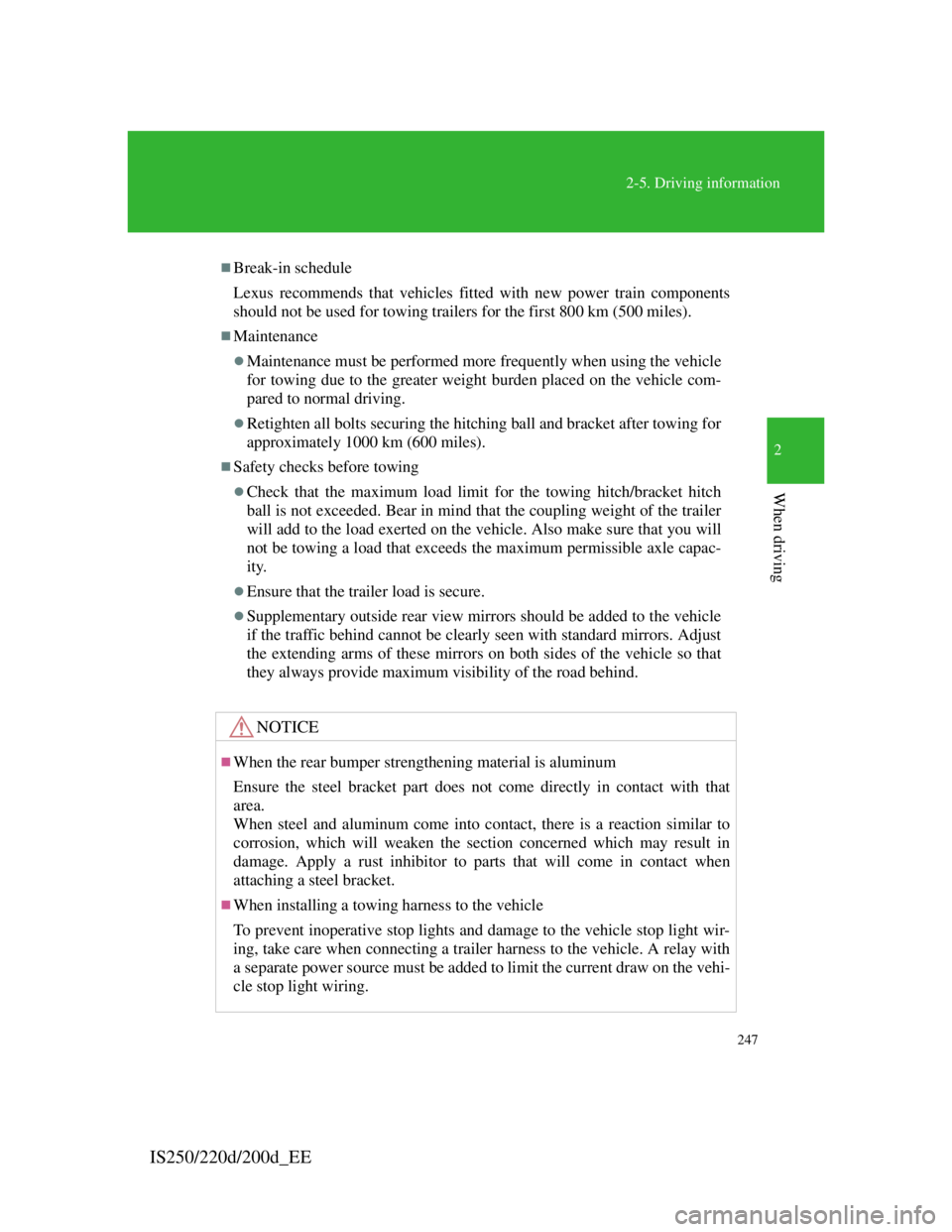
247
2-5. Driving information
2
When driving
IS250/220d/200d_EE
Break-in schedule
Lexus recommends that vehicles fitted with new power train components
should not be used for towing trailers for the first 800 km (500 miles).
Maintenance
Maintenance must be performed more frequently when using the vehicle
for towing due to the greater weight burden placed on the vehicle com-
pared to normal driving.
Retighten all bolts securing the hitching ball and bracket after towing for
approximately 1000 km (600 miles).
Safety checks before towing
Check that the maximum load limit for the towing hitch/bracket hitch
ball is not exceeded. Bear in mind that the coupling weight of the trailer
will add to the load exerted on the vehicle. Also make sure that you will
not be towing a load that exceeds the maximum permissible axle capac-
ity.
Ensure that the trailer load is secure.
Supplementary outside rear view mirrors should be added to the vehicle
if the traffic behind cannot be clearly seen with standard mirrors. Adjust
the extending arms of these mirrors on both sides of the vehicle so that
they always provide maximum visibility of the road behind.
NOTICE
When the rear bumper strengthening material is aluminum
Ensure the steel bracket part does not come directly in contact with that
area.
When steel and aluminum come into contact, there is a reaction similar to
corrosion, which will weaken the section concerned which may result in
damage. Apply a rust inhibitor to parts that will come in contact when
attaching a steel bracket.
When installing a towing harness to the vehicle
To prevent inoperative stop lights and damage to the vehicle stop light wir-
ing, take care when connecting a trailer harness to the vehicle. A relay with
a separate power source must be added to limit the current draw on the vehi-
cle stop light wiring.
Page 262 of 609

248
2-5. Driving information
IS250/220d/200d_EE
Guidance
Your vehicle will handle differently when towing a trailer. In order
to avoid accident, death or serious injury, keep the following in
mind when towing:
Checking connections between trailer and lights
Stop the vehicle and check the operation of the connection
between the trailer and lights after driving for a brief period as
well as before setting off.
Practicing driving with a coupled trailer
Get the feel for turning, stopping and reversing with the trailer
coupled by practicing in an area with no or light traffic.
When reversing with a coupled trailer, hold the section of the
steering wheel nearest to you and rotate clockwise to turn the
trailer left or counterclockwise to turn right. Always rotate
gradually to prevent steering error. Have someone guide you
when reversing to lessen the risk of accident.
Increasing vehicle-to-vehicle distance
At a speed of 10 km/h (6 mph), the distance to the vehicle run-
ning ahead of you should be equivalent to or greater than the
combined length of your vehicle and trailer. Avoid sudden brak-
ing that may cause skidding. Otherwise, the vehicle may spin
out of control. This is especially true when driving on wet or
slippery road surfaces.
Sudden acceleration/steering input/cornering
Executing sharp turns when towing may result in the trailer col-
liding with your vehicle. Decelerate well in advance when
approaching turns and take them slowly and carefully to avoid
sudden braking.
Page 263 of 609

249
2-5. Driving information
2
When driving
IS250/220d/200d_EEImportant points regarding turning
The wheels of the trailer will travel closer to the inside of the
curve than the wheels of the vehicle. To make allowance for this,
take the turns wider than you would normally.
Important points regarding stability
Vehicle movement resulting from uneven road surfaces and
strong crosswinds will affect handling. The vehicle may also be
rocked by passing buses or large trucks. Frequently check
behind when moving alongside such vehicles. As soon as such
vehicle movement occurs, immediately start to decelerate
smoothly by slowly applying the brakes. Always steer the vehi-
cle straight ahead while braking.
Passing other vehicles
Consider the total combined length of your vehicle and trailer
and ensure that the vehicle-to-vehicle distance is sufficient
before executing lane changes.
Transmission information
Refrain from driving in 6 (manual transmission) or 4 range in S
mode (automatic transmission) to maintain the effectiveness of
the engine brake and the charge performance of electrical com-
ponents.
If the engine overheats...
Towing a loaded trailer up a long steep incline in temperatures
exceeding 30C (85F) may result in the engine overheating. If
the engine coolant temperature gauge indicates that the engine is
overheating, turn the air conditioning off immediately, leave the
road and stop the vehicle in a safe place. (P. 525)
When parking the vehicle
Always place wheel chocks under the wheels of both the vehicle
and trailer. Firmly set the parking brake and shift the shift lever
to P for automatic transmissions, and 1 or R for manual trans-
missions.
Page 267 of 609
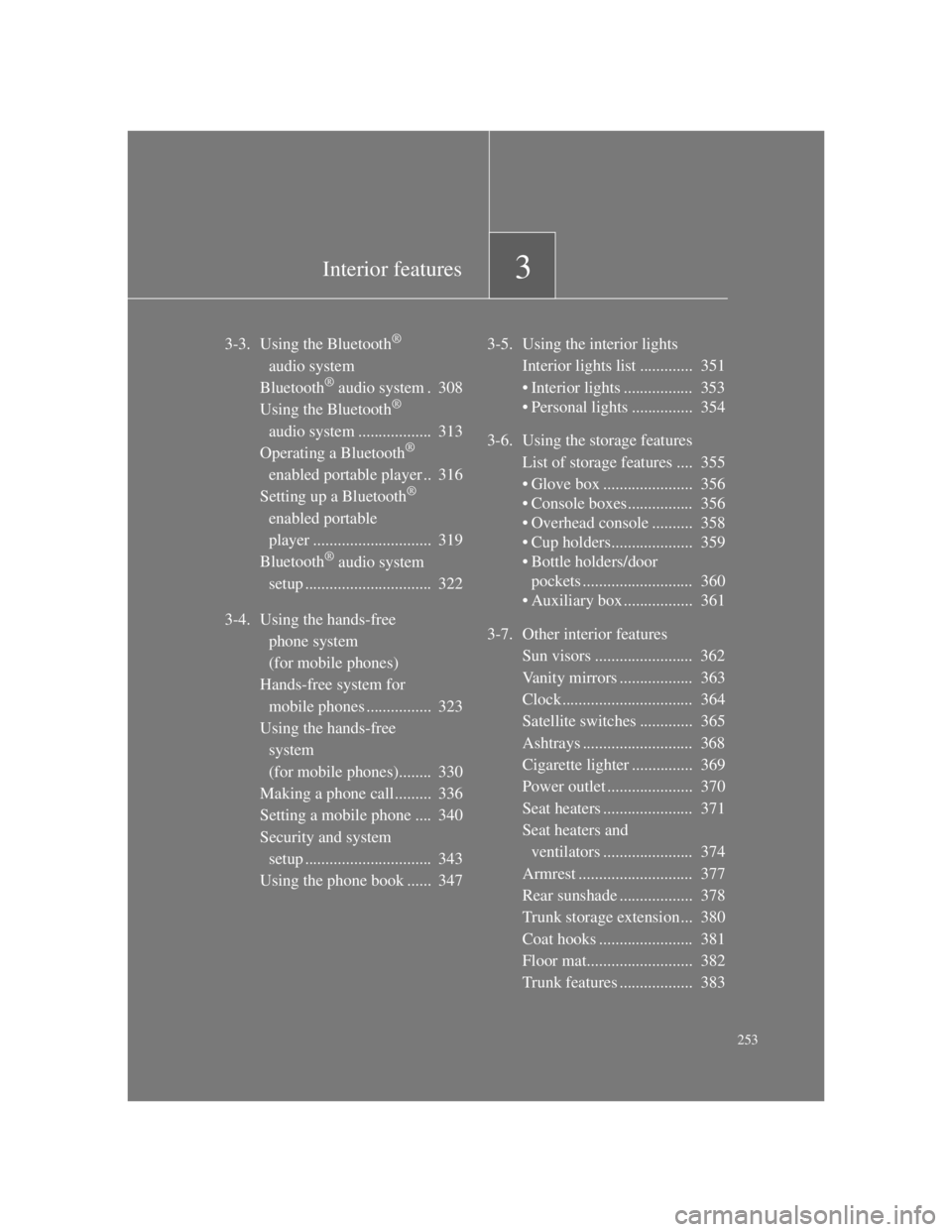
3Interior features
253
3-3. Using the Bluetooth®
audio system
Bluetooth
® audio system . 308
Using the Bluetooth®
audio system .................. 313
Operating a Bluetooth
®
enabled portable player .. 316
Setting up a Bluetooth
®
enabled portable
player ............................. 319
Bluetooth
® audio system
setup ............................... 322
3-4. Using the hands-free
phone system
(for mobile phones)
Hands-free system for
mobile phones ................ 323
Using the hands-free
system
(for mobile phones)........ 330
Making a phone call ......... 336
Setting a mobile phone .... 340
Security and system
setup ............................... 343
Using the phone book ...... 3473-5. Using the interior lights
Interior lights list ............. 351
• Interior lights ................. 353
• Personal lights ............... 354
3-6. Using the storage features
List of storage features .... 355
• Glove box ...................... 356
• Console boxes................ 356
• Overhead console .......... 358
• Cup holders.................... 359
• Bottle holders/door
pockets ........................... 360
• Auxiliary box ................. 361
3-7. Other interior features
Sun visors ........................ 362
Vanity mirrors .................. 363
Clock................................ 364
Satellite switches ............. 365
Ashtrays ........................... 368
Cigarette lighter ............... 369
Power outlet ..................... 370
Seat heaters ...................... 371
Seat heaters and
ventilators ...................... 374
Armrest ............................ 377
Rear sunshade .................. 378
Trunk storage extension... 380
Coat hooks ....................... 381
Floor mat.......................... 382
Trunk features .................. 383
Page 341 of 609

324
3-4. Using the hands-free phone system (for mobile phones)
IS250/220d/200d_EE
TitlePage
Using the hands-free system
Using the hands-free phone system for
the first time
P. 3 3 3
Making a phone call
Making a phone call
• Dialing by inputting a name
• Speed dialing
•Redial
• Call back
Receiving a phone call
• Answering a phone call
• Refusing a phone call
Transferring a phone call
Using the call history memory
• Dialing
• Storing data in the phone book
• Deleting
P. 3 3 7
Setting a mobile phone
Functions and operation proceduresP. 3 4 1
Security and system setup
Security setting items and operation
procedures
System setup items and operation
procedures
P. 3 4 4
Page 352 of 609

335
3-4. Using the hands-free phone system (for mobile phones)
3
Interior features
IS250/220d/200d_EE
“Setup”
“Security”
“Set PIN”Setting a PIN code
“Phbk Lock”Locking the phone book
“Phbk Unlock”Unlocking the phone book
“Phone
Setup”
“Pair Phone”Registering a mobile phone
“Select Phone”Selecting a mobile phone to
be used
“Change Name”Changing the registered
name of a mobile phone
“List Phones”Listing the registered mobile
phones
“Set Passkey”Changing the passkey
“Delete Phone”Deleting a registered mobile
phone
“System
Setup”
“Guidance Vol”Setting voice guidance vol-
ume
“Device Name”Displaying the Bluetooth®
device address and name
“Initialize”Initializing the system
First menuSecond
menuThird menuOperation detail